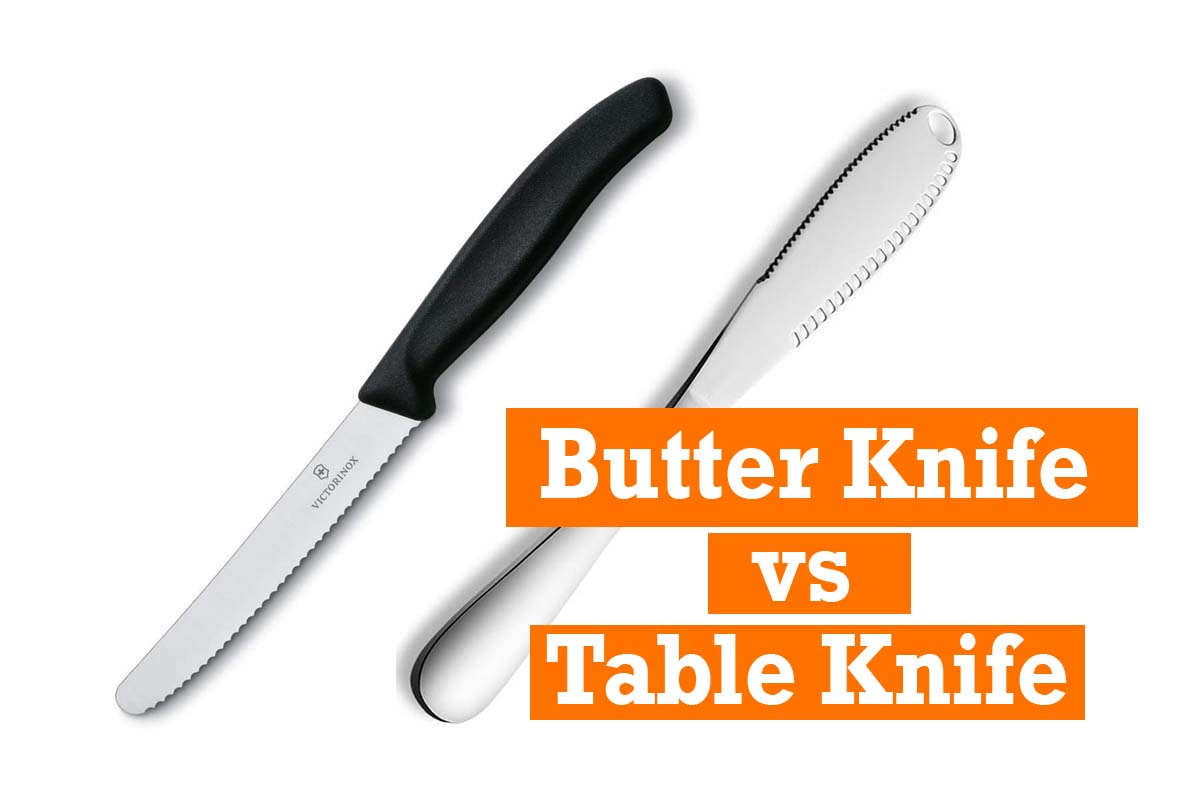Butter Knife vs Table Knife: What You Need to Know

When it comes to dining, understanding the differences between a butter knife vs table knife can improve your experience. In this guide, I’ll compare these two types of knives, highlighting their features and uses.
Knowing which knife to use can make your meals more enjoyable and efficient. Let’s explore the details to ensure you have the right tools for your dining needs.
What is a Butter Knife?
A butter knife is a handy tool in any kitchen. It’s designed for spreading butter and other spreads smoothly. The butter knife has a blunt edge and a rounded tip, perfect for spreading without tearing bread. It’s usually smaller and lighter than other knives, making it easy to handle. Some butter knives, also known as butter spreaders, have a wider blade to hold more spread. This design helps achieve an even layer of butter or other spreads, ensuring a pleasant eating experience.

What is a Table Knife?
A table knife, also called a dinner knife, is a versatile tool found in most cutlery sets. It has a slight serration on the edge, making it suitable for cutting soft foods like vegetables and meats. The table knife features a slightly pointed tip and a longer blade compared to a butter knife, making it more versatile at the dining table.

The dinner knife is an essential part of formal dining settings, often placed beside the plate to the right. Its serrated edge helps cut through food easily, providing a clean cut and enhancing your dining experience.
Key Differences Between Butter Knife and Table Knife
Understanding the knife differences between a butter knife vs dinner knife can help you choose the right tool for the job. Both knives have distinct features and purposes. Let’s compare their size, shape, and edge, and discuss what each knife is best suited for.
Size and Shape
- Butter knives are smaller, typically around 5-6 inches in length. They often have a rounded or semi-pointed tip. This design makes them perfect for spreading without damaging the surface of the bread.
- Table knives are longer, usually between 9-10 inches. They feature a slight serration on the edge, which makes them versatile for cutting various types of food.
By understanding the knife size and knife shape of these tools, you can easily determine which one to use for different tasks. The butter knife size is ideal for spreading, while the table knife size is better suited for cutting.
Edge and Functionality
- Butter knives have a dull edge. This feature is specifically designed for spreading butter and other soft spreads. The blunt edge prevents tearing and helps achieve a smooth, even layer.
- Table knives have a partially serrated edge. This makes them effective for cutting food like soft vegetables, meats, and other items on your plate. The serration helps grip the food, providing a cleaner cut.
When considering the knife edge, the butter knife’s dull edge is perfect for spreading, while the table knife’s serrated edge is ideal for cutting through food.
Material and Design Variations
- Butter knives can be made from a variety of materials, including stainless steel, ceramic, and wood. This variety allows for different styles and preferences, from traditional to modern designs.
- Table knives are typically made of metal, often stainless steel, and are part of flatware sets. Their design is consistent with the rest of the cutlery, ensuring a uniform look at the dining table.
Understanding the knife materials and knife design helps in choosing the right knife for your needs. Butter knives offer a range of materials for different aesthetics, while table knives are usually part of matching flatware sets for a cohesive dining experience.
Uses of Butter Knife
The primary use of a butter knife is for spreading soft substances like butter, jams, and other spreads. Its design, with a blunt edge and rounded tip, makes it perfect for this task. Here’s a closer look at its uses:
- Spread butter: The most common use, allowing you to apply an even layer of butter on bread or toast without tearing it.
- Spread jams and soft spreads: It works equally well for spreading jams, honey, cream cheese, and other soft spreads on various baked goods.
In formal dining settings, the butter knife often has a designated place next to the bread plate. This helps maintain a neat and organized table setting. Its presence in these settings underlines its importance and utility.
Uses of Table Knife
The use of a table knife extends beyond just cutting food. It’s a versatile tool at the dining table, performing several functions:
- Cutting food: Table knives are designed to cut cooked foods like vegetables, meats, and other dishes that are not too tough.
- Helping to push food onto a fork: Often, a table knife is used to guide food onto a fork, especially useful when dealing with slippery or small food items.
- Spreading spreads if necessary: While not its primary function, a table knife can also be used to spread butter or other soft spreads in the absence of a butter knife.
The versatile knife nature of the table knife makes it indispensable in both casual and formal dining settings. It can handle a variety of tasks, making it a key component of any meal.
FAQs on Butter Knife vs Table Knife
Final Thoughts
In this knife comparison summary, we’ve highlighted the unique purposes of each knife.
A butter knife, with its blunt edge, is ideal for spreading butter and soft spreads. This is the butter knife conclusion.
A table knife, with its serrated edge, excels at cutting soft foods and is versatile for various dining tasks. This is the table knife conclusion.
For an optimal dining experience, use a butter knife for spreading tasks and a table knife for cutting and general use.
Understanding these distinctions enhances your dining setup and makes meals more enjoyable.
